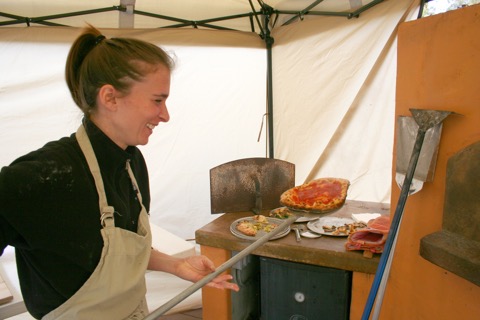Wood-Fired Oven in the Rain

It’s been raining for days. Our winter creek is up and rushing. We always keep the wood covered during the rainy season and this year is no exception. But it’s damp—the humidity’s been around 100% for weeks—so no matter how well-seasoned the wood and how well-protected from the rain—it’s seriously damp. What’s a cook to do when the guests are clamoring for meals from the wfo?
There are a few things you can do to make life easier. Of course, you could line the walls of the living room with logs and play pioneer. Our dog Pinky would love that since he spends a lot of time with his nose in the woodpile sniffing out lizards and other crawly things. Okay, not a great idea. What I really do is keep a wheelbarrow full of logs and kindling in the garage and my emergency tub o’ wood next to the fireplace in the living room. That way I’m always prepared for unexpected guests or wfo students. “Mise en Place,” folks—everything at the ready.
If I’m going to be out there cooking for a couple of days, beloved spouse puts up a giant canopy with fabric walls. It’s cheap and temporary. They only cost about $100 and usually come with screens for the summer, too. Now I’m dry and the wood is dry.
But the oven is damp. So I dry it out slowly with a small fire (up to about 400 degrees) the night before a big cooking day. Once this fire has burned down to ash, I load in some of the damp wood to dry overnight. In the morning, the oven is still warm, the logs are dry, and the fire starts up in no time at all.
In the rain and snow, the oven may require more wood to stay as hot as you like. Of course, that depends on your oven. Every oven I’ve worked with has its own quirks, advantages and disadvantages. It’s one of the great charms of wood-fired cooking--it’s never the same. There’s something special about the results every time.
Stay dry!


